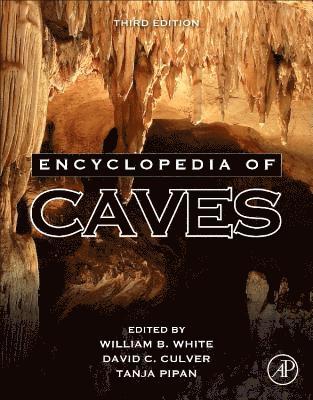
- Format
- Häftad (Paperback)
- Språk
- Engelska
- Antal sidor
- 1250
- Utgivningsdatum
- 2019-06-18
- Upplaga
- 3
- Förlag
- Academic Press
- Medarbetare
- Culver, David C. / Pipan, Tanja
- Dimensioner
- 274 x 218 x 48 mm
- Vikt
- Antal komponenter
- 1
- ISBN
- 9780128141243
- 2384 g
Encyclopedia of Caves
- Skickas från oss inom 5-8 vardagar.
- Fri frakt över 249 kr för privatkunder i Sverige.
Passar bra ihop
De som köpt den här boken har ofta också köpt Technofeudalism av Yanis Varoufakis (häftad).
Köp båda 2 för 1961 krKundrecensioner
Fler böcker av William B White
-
Geomorphology and Hydrology of Karst Terrains
William B White
Recensioner i media
"All in all though, this encyclopedia - now updated to its 3rd Edition - covers a tremendous breadth of cave and cave-related material. It must represent the fruits of stupendous efforts, and doubtlessly it has resulted in a major contribution to cave literature."--Cave and Karst Science
Övrig information
William B. White is Professor Emeritus of Geochemistry at The Pennsylvania State University. He holds a BS degree in chemistry from Juniata College (Huntingdon, PA) and a PhD in geochemistry from Penn State. His 40-year teaching career included a course in the geology of caves and karst. His research has produced 446 technical papers of which 131 deal with aspects of caves and karst. He is author or co-editor of 7 cave-related books including the first two editions of the Encyclopedia of Caves. He is a fellow of the American Association for the Advancement of Science, the National Speleological Society, and the Mineralogical Society of America. David C. Culver received his BA from Grinnell College and his PhD from Yale University. He is Professor Emeritus of Environmental Science at American University. He has studied the ecology, evolution, biogeography, and biodiversity of the subterranean fauna for five decades and has published more than 120 papers in refereed journals, and authored or co-authored four books, two with Tanja Pipan. His studies of the subterranean fauna have taken him to more than 20 countries. He was co-editor with William B. White of the first two editions of the Encyclopedia of Caves. Tanja Pipan received her PhD in biology from the University of Ljubljana. She is currently Research Advisor at the Karst Research Institute, Research Centre of the Slovenian Academy of Sciences and Arts (ZRC SAZU) and Professor of Biology at the University of Nova Gorica. She has broad research interests in subterranean biology, especially biodiversity, biogeography, ecology of shallow subterranean habitats, and ecosystem function. She has extensive experience with a variety of Slovenian subterranean habitats and has done the most extensive ecological study to date of the very rich fauna found in the epikarst. Since 2011 she is an associate editor of the Journal of Speleology for the field of biospeleology. She has travelled extensively in her study of the epikarst and other subsurface habitats.
Innehållsförteckning
A: Adaptation to low food; Adaptations: Low oxygen; Adaptation to darkness; Adaptations: Behavioral;Adaptation: Morphological; Adaptation and natural selection in caves; Adaptive shifts; Anchihaline (Anchialine) caves and fauna; Ancient cavers in Eastern North America; Art in European caves; Asellus aquaticus: A model system for historical biogeography; Astyanax mexicanus: A vertebrate model for evolution, adaptation, and development in caves
B: Bats; Beetles; Biodiversity patterns in Australia; Biodiversity: China; Biodiversity in Europe; Biodiversity in the United States and Canada; Biodiversity in South America; Breakdown; Burnsville Cove, Virginia
C: Camps; Castleguard Cave, Canada; Cave dwellers in Southwest Asia; Cave ecosystems; Cavefishes; Cavefish of China; Definition of cave; Caver communities and organizations: Cultural and historical considerations; Chemolithoautotrophy; Clastic sediments in caves; Closed depressions in karst areas; Coastal caves; Collembola; Contamination of cave waters by heavy metals; Contamination of cave waters by nonaqueous-phase liquids; Crustacea; Dating cave sediments with cosmogenic nuclides
D: Dating cave sediments with cosmogenic nuclides; Dinaric karst-Geography and geology; Biodiversity in the tropics; Documentation and databases
E: Ecological and evolutionary classifications of subterranean organisms; Entrances;
Environmental DNA as a conservation tool; Epikarst; Epikarst communities; Exploration of caves-General; Exploration of caves: Underwater exploration; Exploration of caves-Vertical caving techniques
F: Folklore, myth, and legend, caves in; Food sources; The Frasassi Caves, Italy; Friars Hole System
G: Gammarus minus: A model system for the study of adaptation to the cave environment; Geophysics for locating karst and caves; Glacier caves; Guano communities; Gypsum caves; Gypsum flowers and related speleothems
H: Hang Son Doong and other caves of the Phong Nha-K? Ba`ng karst, Qu?ng Bi`nh Province, Vietnam; Helictites and related speleothems; History: Caves and other underground spaces in medieval Britain and Ireland; Huautla cave system (Sistema Huautla), Mexico; Hydrogeology of Karst aquifers; Hydrothermal caves
I: Ice in caves; Iron formation caves: Genesis and ecology; Isotopes in karst waters and cave sediments
J: Jewel cave, South Dakota
K: Karren, cave; Karren, surface; Karst; Kazumura Cave, Hawaii; Krubera (Voronja) cave
L: Lampenflora; Lechuguilla Cave, New Mexico; Life histories
M: Magnetism of cave sediments; Mammals and birds-vertebrate visitors; Mammoth Cave System, Kentucky; Mapping subterranean biodiversity; Maya caves; Microbes; Minerals in caves; Modeling of karst aquifers; Modeling the evolution of karst
aquifers; Molluscs; Mulu caves, Malaysia; Myriapods
N: Niphargus-A model system for evolution and ecology; Nitrate contamination in karst groundwater; Nu...
Du kanske gillar
-
Source Code
Bill Gates
Inbunden -
This Mortal Coil
Andrew Doig
Häftad -
The Way Home
Mark Boyle
Häftad -
Big Cloud
Camille Seaman
Inbunden -
Nexus
Yuval Noah Harari
Häftad


